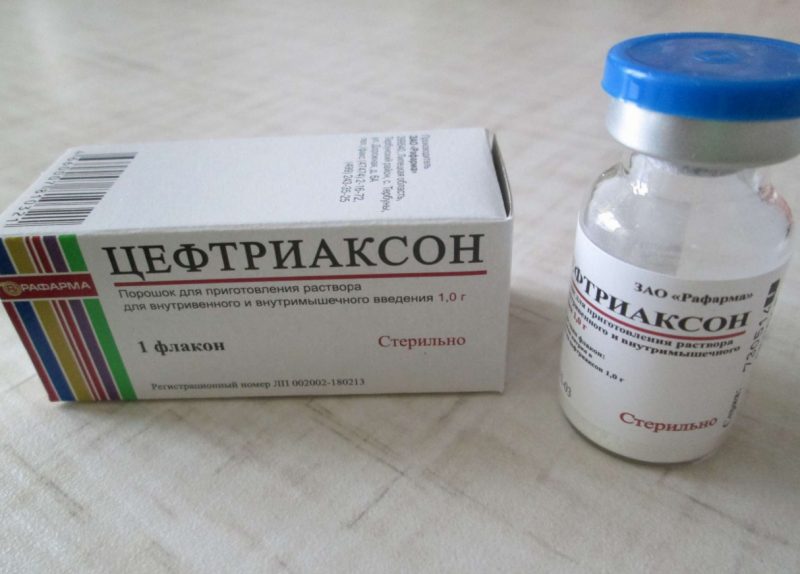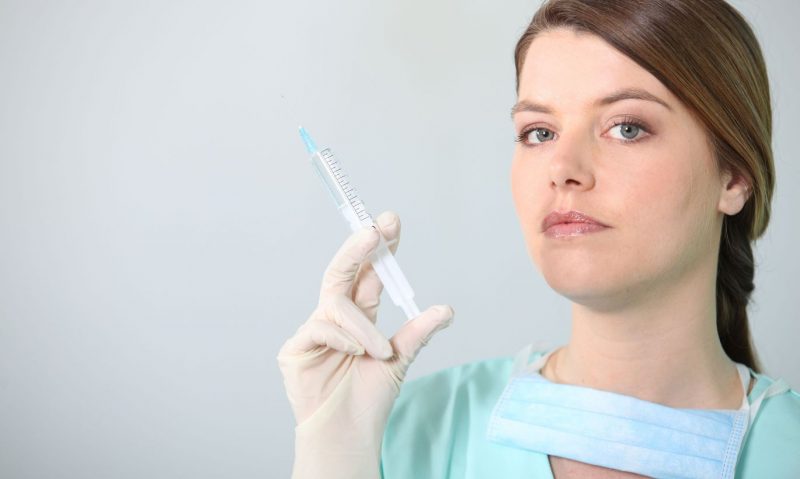Ceftriaxone is an antimicrobial drug. This is a potent medicine that is used strictly as directed by a doctor. Ceftriaxone injections are indicated for infectious diseases of a bacterial nature, accompanied by the rapid development of inflammatory processes within the body. In order for the drug to benefit and not harm health, you must strictly follow the instructions, and also follow all the recommendations of the doctor who prescribed the drug.
Material Content:
- 1 The composition of the antibiotic
- 2 Which group of antibiotics belongs
- 3 Pharmacological properties and pharmacokinetics
- 4 Why is the drug prescribed for adults and children
- 5 Instructions for the use of Ceftriaxone injections
- 6 Ceftriaxone injections during pregnancy and lactation
- 7 Can I drink alcohol while taking the drug
- 8 Drug Interactions with Other Drugs
- 9 Contraindications, side effects and overdose
- 10 Ceftriaxone analogues in injections
The composition of the antibiotic
Ceftriaxone is sold in powder form. It is a crystalline, white, or slightly yellowish substance. It is packed in ampoules and is intended for further preparation of the solution. The composition includes ceftriaxone sodium salt. It is this substance that will exhibit antimicrobial activity. In pharmacies, ampoules with different amounts of active substance are presented.

It could be:
- 0.25 g;
- 0.5 g;
- 1 g;
- 2 g
The dosage and volume of the ampoules is selected by the doctor after a full analysis of the patient and receiving answers according to the tests submitted to him.
Which group of antibiotics belongs
Ceftriaxone is a chemical belonging to the category of cephalosporins. This is a third generation drug.Such drugs have an extended spectrum of action, improved pharmacokinetic parameters.

They are most resistant to enzymes that are secreted by bacteria. Consequently, their effectiveness will be higher compared with some other groups of antibiotics, in particular, with penicillin preparations.
Pharmacological properties and pharmacokinetics
Ceftriaxone antibiotic is considered a universal remedy that helps fight different types of bacteria.

Its effect is due to the ability of a chemical compound in its composition to inhibit the formation of cell walls in bacteria. As a result, pathogens die. The scale of their colonies is rapidly decreasing. The disease recedes, and the person's condition stabilizes. With this antibiotic, three types of bacteria can be destroyed.
- Anaerobic microorganisms. The antibiotic is active against almost all microbes living in the absence of oxygen.
- Aerobic gram-positive microbes. Most often, the medicine is used against streptococci of various groups.
- Aerobic gram-negative microbes. The antibiotic quickly destroys xibella, diplococci, proteins and the most common bacteria - Escherichia coli.
When ingested inside the body, the medicine rushes into the systemic circulation. There it binds to plasma proteins. The concentration of the active substance remains high for a long period. This figure can reach 96%. With intramuscular administration, it is 8 - 9 hours, and with intravenous administration, increase up to 15 hours.
The spent medicine is excreted unchanged from the body. The kidneys and the liver are involved in the process of removing the antibiotic. About half of the substance, along with bile, is excreted into the lumen of the gastrointestinal tract and disposed of with the remains of digested food.
Why is the drug prescribed for adults and children
"Ceftriaxone" is prescribed for the treatment of pathologies associated with the penetration of pathogenic bacteria into the body. Before the appointment, the doctor must make sure that the strain of microbes present inside the body is sensitive to the selected drug. In the opposite case, therapy will not have the desired effect.

The main indications for using the antibiotic are:
- gonorrhea;
- salmonellosis;
- Lyme disease
- syphilis;
- bacterial meningitis;
- endocarditis;
- sepsis;
- infected wounds;
- infected burns.
Read also: Lyme disease - what is it
Most often, the medicine is prescribed for infections of ENT organs - tonsillitis, sinusitis, pneumonia, bronchitis, lung abscess.
The list of indications includes pathologies of the urinary system, in particular cystitis, pyelonephritis. Do not do without medication in the treatment of inflammatory processes associated with infection by bacteria in the abdominal cavity, for example, peritonitis.
Instructions for the use of Ceftriaxone injections
The drug can be prescribed to adult patients or children. The age of the patient directly affects the dosage of the drug. The tactics of administering the drug will be uniform.

The crystalline drug is diluted and converted into a solution that is administered intramuscularly. Water for injection is allowed, but Ceftriaxone is best diluted with a substance with a moderate analgesic effect - lidocaine. 2 ml of solvent (1% lidocaine) is taken per 0.5 g of the drug.
Important! Ceftriaxone dissolved in lidocaine is administered exclusively intramuscularly. It is forbidden to inject such a solution into a vein.
For adults
The dosage for adult patients and children over 12 years old is 1 - 2 grams of active substance per day. This volume can be entered once or divided into two doses with an interval of 12 hours.

After consultation with the attending physician, a dose increase of up to 4 grams per day is allowed, provided that the patient's condition is regarded as severe.
"Ceftriaxone" can be used as a prophylactic to prevent the penetration of pathogenic agents into the body, for example, before surgery. In this case, the patient is shown once to enter the minimum dose of the drug (1 or 2 grams, depending on weight).
For children
For the treatment of bacterial infections in children, Ceftriaxone is prescribed depending on weight. Those who have a body weight of more than 50 kg are given a dose suitable for an adult.

The usual dosage for children under 12 years old ranges from 20 to 75 mg per 1 kg of body weight. The more severe the disease and the more pronounced the symptoms, the greater the dosage. Injections are carried out once or twice a day.
Ceftriaxone injections during pregnancy and lactation
The immunity of a woman expecting a baby often weakens, which leads to the penetration of pathogenic bacteria into the body. With the development of an infectious disease, treatment must be started immediately, before the colony becomes too large.

Particular attention should be paid to your health in the first trimester. During this period, the active laying of all internal organs of the fetus occurs. A pregnant woman should not take any medicine without the permission of a doctor. This can provoke pathology of fetal development. Ceftriaxone is on the list of drugs that are potentially dangerous during pregnancy, so it is abandoned in the first trimester.
You can not do injections during lactation. If necessary, treatment with this antibiotic, the baby is transferred to artificial feeding.
Can I drink alcohol while taking the drug
Alcohol and antibiotic drugs are incompatible. The doctor prescribing the injection will immediately warn about this. Drinking alcohol during the course of therapy is prohibited at the same time for several reasons.

- Both antibiotic and ethyl alcohol increase the load on the liver many times. This body is forced to remove a huge amount of toxins, which disrupts its work. The risk of damage to the tissues of the gland and the death of its cells increases.
- Alcohol used during antibiotic therapy increases the risk of side effects. As a result, the medicine is tolerated much worse than the instructions for it suggest.
- Alcohol reduces the effectiveness of even such powerful drugs. As a result, the bacterial colony is not completely destroyed, and after some time the remaining units of microbes form a new antibiotic-resistant colony.
For fast and effective drug treatment, it is worth giving up alcohol. It is allowed to drink alcohol in minimal doses only a day after the last injection.
Drug Interactions with Other Drugs
Ceftriaxone is often prescribed to adults and children as part of the complex therapy of diseases of a bacterial nature. It is important to understand how this medicine will interact with other drugs.

So, this antibiotic is incompatible with other antimicrobial drugs. This means that the doctor will prescribe only one medication. It is impossible to supplement injections with any tabletted forms of antibiotics.
"Ceftriaxone" negatively affects the state of microflora of the final sections of the gastrointestinal tract. It does not have selectivity and even destroys beneficial bacteria. Therefore, during therapy, eubiotics may be required in parallel. They go well with cyclosporins. The doctor can prescribe one of the most effective drugs for the restoration of intestinal microflora - Linex, Acipol.
Contraindications, side effects and overdose
Antibiotics are powerful drugs that can be used to eliminate pathogenic bacteria. Treatment should be carried out with extreme caution, since the risk of worsening health remains high due to the negative effect of drugs on the liver and kidneys.

Ceftriaxone is not prescribed for:
- individual intolerance;
- renal failure;
- severe liver pathologies;
- first trimester of pregnancy;
- lactation.
The medicine should not be given to premature babies. In all other cases, it will be an excellent helper for getting rid of bacterial infections.
During therapy, it is important to adhere to the instructions, since an excess dose or an increase in the course can provoke side effects or symptoms of an overdose.
The list of the most likely side effects includes:
- fever;
- hives;
- decrease in the amount of urine;
- headache;
- flatulence;
- diarrhea;
- nosebleeds.
Most often, against the background of taking any antibiotics, dysbiosis develops, characterized by an alternation of intestinal disorders. For its prevention, drugs are prescribed that stimulate the growth of their own beneficial microflora.
With a significant excess of the recommended volume, signs of an overdose develop. As a rule, they are associated with excitation of the central nervous system. The patient may develop cramps, paralysis of the limbs. It is important to consult a doctor and inform him about the medicine you are taking.
Ceftriaxone analogues in injections
Ceftriaxone is a powerful antibiotic. Injection form allows you to almost instantly introduce substances into the bloodstream, which ensures rapid achievement of the goal. Doctors often prescribe this remedy for severe pathologies or low effectiveness of drugs in the form of tablets.

Analogs can also be used, the list of which includes:
- Zephson
- "Ificef";
- Cefaxon
- Chizon;
- Medaxon
All of these drugs have a similar composition and similar mechanism of action. The decision about the need to replace Ceftriaxone with another drug is made by the doctor. He will explain how to use the drug correctly in order to minimize the risk of side effects.












